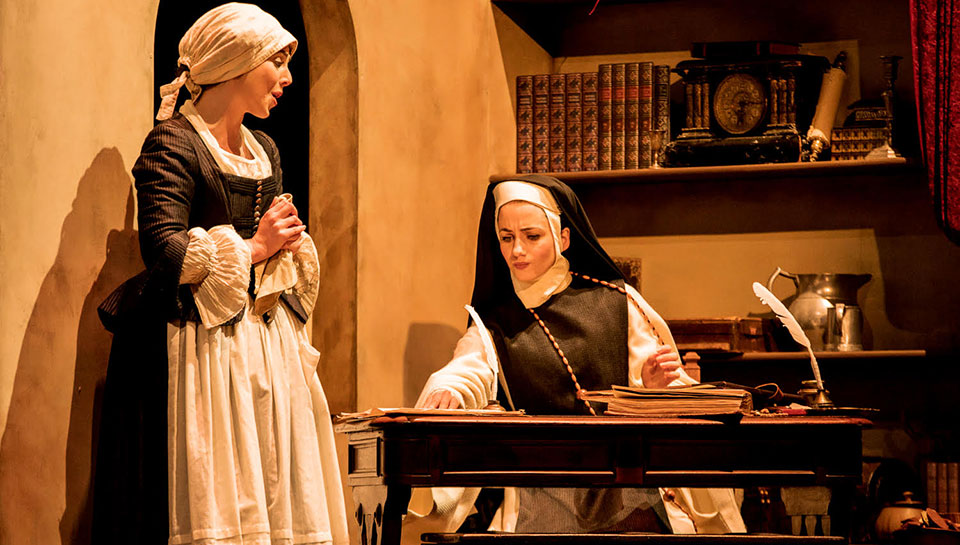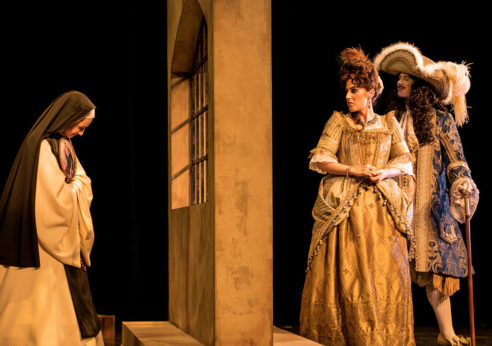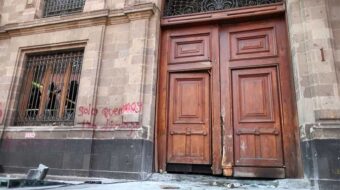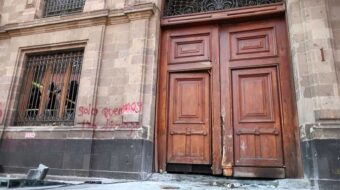
LOS ANGELES—Until artist Frida Kahlo joined the choir of feminist saints, the most famous woman of culture from Latin America was the 17th-century nun Sor Juana Inés de la Cruz (1648-95). (I am not including Evita Perón as a woman of culture although one of the most popular musicals of the 20th century bears her name, nor am I including the Virgen de Guadalupe, whose visage is ubiquitous throughout Mexican communities at home and abroad.)
Though highly distinguished, Sor (Sister) Juana was actually not all that well known to the general public until Mexican author and 1990 Nobel Prize winner for Literature Octavio Paz (1914-98) published his massive biography, Sor Juana: Or, the Traps of Faith. Sor Juana’s portrait appears on Mexico’s 200-peso banknote.
Alicia Gaspar de Alba is a professor and founding faculty member of the UCLA César Chávez Department of Chicana/o Studies and former chair of the LGBTQ Studies Program. Her most recent academic book, (Un)Framing the ‘Bad Woman’: Sor Juana, Malinche, Coyolxauhqui and Other Rebels with a Cause, was published in 2014. Earlier, in 1999, she had written a novel, Sor Juana’s Second Dream, upon which the opera is based. Gaspar de Alba and the composer Carla Lucero co-wrote the libretto in Spanish.
Juana arrived at UCLA’s Freud Playhouse stage for two performances on Nov. 22 and 24 (I attended Nov. 22), presented by the combined forces of Opera UCLA, the UCLA Herb Alpert School of Music, and the UCLA School of Theater, Film and Television. The conductor was Mary Chun, and the director Sara E. Widzer. Almost the entire production team were women. The opera comprises two substantial acts with numerous scenes in each, for a total of three hours with one intermission.
Sor Juana entered the convent in Mexico City at age 19. The safety of the convent protected her from the inevitable fate of a suffocating marriage, and perhaps exposed her to the charms of her company of nuns (certainly one reason why so many gay men became priests). In any case, cloistered from the world, Juana could be free, privileged by the court to some extent because of her renown, to pursue her literary studies and other projects.
In fact, we meet her at the beginning of the opera as she is designing, on commission from the Church, a ceremonial arch to be erected in the city to welcome the new viceroy and vicereine, known as La Condesa. We see her later on participating in an ambitious course of letter writing, making poetry, arguing theology, and deftly wending her way through the thickets of male superiors who are demonstrably her intellectual inferiors.
Juana is not the first opera to take place in a convent: Francis Poulenc’s Dialogues of the Carmelites comes to mind and, of course, Giacomo Puccini’s one-act Suor Angelica. Nor indeed the first opera about Juana: The Fort Worth Opera, five years ago, presented With Blood, With Ink, by Daniel Crozier. Fruitful comparisons could also be made to operas about the other “Juana”—that is, Jeanne, or Joan of Arc, of which there are several, notably by Verdi and Tchaikovsky—an equally feisty young woman (and also possibly a lesbian) who took on the male establishment and soared to historical prominence.
(And plumbing the depths of the truly obscure, there was also Gian Carlo Menotti’s opera La Loca—The Madwoman—about Juana (1479-1555), the mentally unstable Queen of Castile, a highly educated daughter of King Ferdinand and Queen Isabella, married to Philip the Handsome, Archduke of the House of Habsburg in 1496, and mother of Charles V. She was kept locked up in Tordesillas for the last almost five decades of her life. It was one of Beverly Sills’s last roles at the New York City Opera. I reviewed this work 40 years ago for the Daily World (predecessor of People’s World) on September 25, 1979, which became the source of one of my all-time favorite stories about journalistic gaffes. I remarked of Menotti’s gloomy score that “Curiously, the orchestra occasionally drifts into noticeable strains of Viennese operetta…,” which was the correction published two days later. In the original review, however, the DW editors had curiously substituted “Vietnamese” for “Viennese,” which would have been curious indeed!)
As unique and important as Sor Juana was, and remains still, as a forward-looking thinker and activist in colonial Mexico, it’s also important to remember that she was not entirely alone. Both within and outside the walls of the Church, there were others, such as Fray Bartolomé de las Casas, who argued that the Indigenous peoples of the New World do have souls and should not be subjected to slavery. Others, horrified by the wanton destruction of Native artifacts and documents, learned their languages and helped Native artists recapture their history, mythology and culture in newly commissioned parchment re-creations, which survive today. Difficult as it was to challenge corruption, ignorance and cruelty, some people of conscience did.
Scenic designer Madie Hays imagined a stage suggesting the Spanish colonial environment with arches and ochre plaster walls. Within those walls, Sor Juana constantly has to watch her back: There are spies, snoops, intriguers and eavesdroppers everywhere, eager to curry favor by yanking her down a notch or two with the authorities and eventually turning her over to the Inquisition. Other characters, such as her confessor, Padre Antonio (Justin Birchell), the Bishop of Puebla (Eric Levintow), and the Archbishop (Michael Valentekovic), not to mention the Mother Superior, Madre Melchora (Michelle Rice), are stock villains totally ingratiated with the Inquisition and harsh colonial rule. The friend she thought she had in Don Carlos (Alexander Papandrea) turns out to be a shameless opportunist in the end. The Archbishop in particular has an especially vivid and violent personality disorder barely concealed under the cloak of his faith: Believing that women do not possess souls, he will not be in the presence of any woman, even a servant or cook, nor eat food prepared by a woman, threatening to have any woman beaten who transgresses his space.
This is far from the only expression of religiously inspired obscurantism. In one scene the nuns flagellate themselves to protect the convent from an epidemic that is sickening the land, believing that pain and self-sacrifice will end the plague. Suffering in the orthodox Catholic mind leads to salvation. Indians are revolting and protesting the lack of food brought on by a crop-infesting weevil. Soldiers of the Crown shoot into the crowds and kill many. The Church is often seen as abstracting itself from worldly concerns, but by any objective measure it is part of the oppression. Juana herself died from one of the epidemics that swept Mexico in 1695.
Juana from her earliest childhood showed prodigious talent for learning and thinking. At the age of 19 she was brought before a panel of forty learned men from the University of Mexico who tested her command of literature, philosophy and theology. She acquitted herself with honor, even showing familiarity with ancient texts prohibited by the Church. There was not another woman in New Spain, nor anywhere in the Americas, with her education and brilliance. A few flashbacks in the opera bring us short scenes from her past—the Young Juana is sung by Natalie Leonard, who doubles as Juana’s amanuensis Concepción in the convent. Of course the men considered her a “show-off”—that is, she was inherently smarter than any of them and just as well educated. She joined the convent shortly afterward, knowing she would get nowhere in a world that knew nothing of “equal opportunity.”
El Alma (Carmen Voskuhl) is a ghostly apparition clad in sparkling dress and feathery headdresses, originally written for a sexually ambiguous countertenor but in this performance sung by a tall, thin mezzo soprano, quoting from Plato’s Symposium about the three genders and desire. This spirit returns to sing excerpts from Sor Juana’s poetry and to offer warnings of tragedy. A non-binary figure, El Alma (“The Soul”) gathers the collective wisdom of ancient civilizations both European and Mesoamerican. The staging suggests that El Alma is voicing the thoughts of Sor Juana herself, who is seen writing at her desk. How much, or little, Juana knew about Indigenous culture is not brought out in the opera.
More than one reference is made to the ancient Greek poet Sappho, a kind of lesbian patron saint, and Juana pulls no punches in clearly identifying its protagonist as a member of the tribe. Her most famous poem, “You Foolish Men,” justifies her reputation as the “first feminist of the New World.” It begins
You foolish men, so very adept
At wrongly faulting womankind,
Not seeing you’re alone to blame
For faults you plant in woman’s mind.
After you’ve won by urgent plea
The right to tarnish her good name,
You still expect her to behave
You, that coaxed her into shame.

The object of her affections is the cigarillo-smoking Vicereine, “La Condesa” (Michelle Drever), who is the closest to Juana’s intellectual equal cum sexual fantasy as she would ever meet. The opera has several scenes where La Condesa lubriciously reads Juana’s passionate letters, and their love for one another is fully consummated by the end of Act I. When we first meet her, though, she’s with the foppish Viceroy (Mario Arias), who admits he doesn’t understand Juana’s poem. So Juana sums it up succinctly for him: “Men want to go to bed with Mary Magdalene and wake up with the Virgin Mary.”
The Vicereine and her husband are recalled to Spain after some years, where she will become Juana’s literary agent and advocate, succeeding in publishing several volumes of her writings. This alone was an extraordinary achievement for a woman of her time, and a colonial at that.
Lucero’s orchestra is a small consortium of wonderment, capable of rendering “Indigenous”-sounding accompaniments to the singing as well as baroque counterpoint. There are even some jazz riffs to be heard. Aside from a string quartet plus bass, she includes two percussionists (bells are a prominent feature of the score), an alto recorder and ocarina (sounding like a pre-Columbian flute), guitar, harp, vihuela (an old Spanish guitar) and harpsichord.
Aside from her soloists, all of whom are UCLA students or 2019 graduates, Lucero also writes effectively for the women’s chorus of nuns. She gives us several stand-out solos and duets, including some ecstatic love scenes (Juana is a mezzo and La Condesa is a high soprano). Her aesthetic is contemporary but accessible and inviting.
Juana is the centerpiece of it all and appears in almost every scene. The character reaches her apotheosis in the Inquisition scene where she is instructed to renounce all her writings. She does so, against her will, signing in her own blood, but insists she would still want them published. As for love, she sings, “I will not retreat. If it is a crime, I must avow it.” Judging from this promising outing, Meagan Martin has an important career ahead of her.
The wonderful news is that Juana seems to have a future: The printed program announces subsequent performances of the opera in New York by dell’Arte Opera in August 2020. Feminists, opera lovers, anyone interested in Sor Juana and Mexican history, all would be enchanted by this fresh new work. It deserves professional attention.












Comments